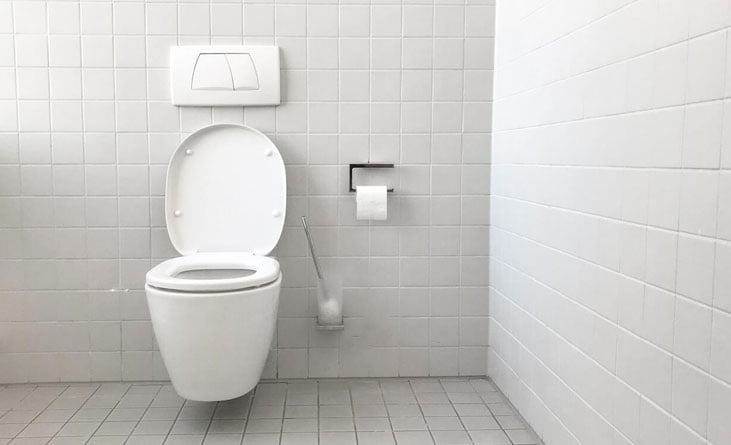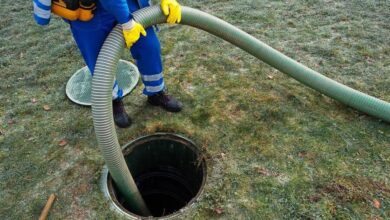Understanding the Differences: Water Closet vs Lavatory

When it comes to bathroom fixtures, the terms water closet and lavatory are often used interchangeably, creating confusion for many. To make an informed decision about which fixture to install in your bathroom, it’s crucial to understand the differences between these two fixtures.
A water closet is essentially a smaller room within a bathroom that is used for the purpose of defecation and urination. It is equipped with a toilet and a water tank for flushing. On the other hand, a lavatory, also known as a sink or a washbasin, is a fixture used for washing hands, face, and other body parts.
The definitions of these two fixtures may seem simple, yet they hold significance in the context of plumbing and bathroom design. In this article, we will explore the definitions of water closet and lavatory in detail, highlighting their unique features and functions. By the end of this article, you will be able to distinguish between a water closet and a lavatory and understand which one suits your bathroom needs best.
So, let’s dive deeper into the world of water closets and lavatories and understand what each of them entails.
What is a Water Closet?
A water closet, also known as a WC or simply a toilet, is a fixture that is designed for the disposal of human waste. It is an essential component of any modern bathroom and is typically located in a separate room or enclosed space.
The term “water closet” refers to the fact that this fixture uses a flushing mechanism to dispose of waste, which involves the use of water. The water is stored in a tank or cistern located above or behind the fixture, which can be activated by a lever or button to release the water into the bowl and flush away the waste.
The water closet comes in various types, including the traditional two-piece toilet, which consists of a separate tank and bowl, and the more modern one-piece toilet, which has a seamless design. There are also wall-mounted and floor-mounted models, as well as elongated and round bowls to suit different user preferences.
Overall, a water closet is an essential fixture in any bathroom that provides a private and hygienic way to dispose of waste.
What is a Lavatory?
A lavatory, also known as a sink or washbasin, is a plumbing fixture that is commonly found in bathrooms and kitchens. It is typically used for washing hands, faces, and other small items.
The definition of a lavatory can vary depending on its location within a building. In a bathroom, a lavatory may also include a countertop and storage area, while in a kitchen, it may be accompanied by a dishwasher or other appliances.
Most lavatories consist of a basin, faucet, and drainage system. The basin may be made of various materials such as porcelain, ceramic, or glass, and may be installed in a countertop, vanity, or wall-mounted.
The Many Uses of a Lavatory
The primary use of a lavatory is for personal hygiene, such as washing hands, faces, and brushing teeth. It is also commonly used for cleaning small items, such as makeup brushes or razors.
However, lavatories have found many other uses beyond their intended purposes. They are often used for filling up water bottles, rinsing off dirty dishes or utensils, and even washing pets.
The Different Types of Lavatories
Lavatories come in many different types, each with its unique features and functions. Some common types include:
- Wall-mounted: attached directly to the wall and does not have a countertop
- Countertop: installed on top of a countertop or vanity
- Pedestal: supported by a pedestal or column rather than a countertop
- Vessel: sits on top of the counter or vanity, rather than being mounted into it
The choice of lavatory type will depend on factors such as the desired aesthetic, available space, and personal preferences.
Key Differences between Water Closets and Lavatories
While both water closets and lavatories serve important functions in a bathroom, there are several key differences between the two fixtures. Here are some of the main contrasts:
| Water Closets | Lavatories |
|---|---|
| Designed for waste disposal (urine and feces) | Designed for handwashing, facewashing, and teeth brushing |
| Often referred to as “toilets” | Often referred to as “sinks” |
| Usually located in a separate enclosed space | Can be located inside or outside of an enclosed space |
| Has a water tank for flushing waste down a drain | Uses running water from a faucet to wash hands and face |
Another main difference between water closets and lavatories is that water closets often require a dedicated water supply and drain, whereas lavatories can be connected to a shared water supply and drain with multiple fixtures. Additionally, water closets tend to have a larger footprint and take up more space in a bathroom than lavatories.
Water Closet vs Sink
One common misconception is that a lavatory is the same as a sink. While a lavatory can sometimes be referred to as a sink, it is not the same thing as a kitchen sink or utility sink. A lavatory is specifically designed for washing hands, face, and teeth and is typically smaller than a kitchen or utility sink. A water closet, on the other hand, is designed for waste disposal and is not a sink at all.
Lavatory vs Water Closet
The main difference between a lavatory and a water closet is their primary function. While a lavatory is designed for washing and grooming, a water closet is designed for waste disposal. Additionally, water closets are often located in a separate enclosed space, while lavatories can be located inside or outside of an enclosed space. The fixtures also have different water supply and drainage requirements.
Understanding the differences between water closets and lavatories is important when planning and designing a bathroom. By considering the function, location, and water supply needs of these fixtures, you can create a space that is both functional and aesthetically pleasing.
Common Uses and Misconceptions
Water closets and lavatories are essential fixtures in any modern bathroom. However, there are common misconceptions about their uses and functions. In this section, we will clarify some of these misconceptions.
Lavatories are Sinks
Many people use the terms “lavatory” and “sink” interchangeably. While a sink is a type of lavatory, not all lavatories are sinks. A lavatory is a fixture that is mainly used for washing hands and faces, while a sink is used for a variety of tasks such as washing dishes, cleaning, and more.
Lavatory vs. Bathroom
Another common misconception is that a lavatory refers to the entire bathroom. However, a lavatory is just one of the many fixtures in a bathroom, which also includes a shower, bathtub, toilet, and more.
Water Closet Uses
Water closets are primarily used for private bodily functions. However, they can also be used for other purposes such as disposing of trash. In some countries, water closets are used to wash clothes due to a scarcity of water resources.
When choosing between water closets and lavatories, it is important to consider their specific uses and functionalities. While both fixtures are crucial to a functional bathroom, they serve different purposes and should be selected accordingly.
Historical Significance: Why is it Called a Water Closet?
Have you ever wondered why a water closet is called by that name? The term “water closet” has been in use for centuries, and it originated in 16th-century England. In those days, indoor plumbing was rare, and most houses had outdoor privies that were little more than holes in the ground. The closet referred to a small, enclosed room, while the water referred to the flushing mechanism.
However, the use of the term “water closet” didn’t become widespread until the 19th century, when indoor plumbing and flush toilets became more common. The phrase “water closet” was initially an upper-class euphemism for what had previously been known as the garderobe or the privy.
The abbreviation “W.C.” for bathroom or toilet is derived from “water closet” and is still used in many parts of the world.
Water Closet and Lavatory in Modern Plumbing
In today’s world, water closets and lavatories have become essential components of modern bathrooms. Advancements in plumbing technology have made it possible for us to have a steady and clean water supply that we can use to flush our waste and wash our hands.
Indoor Plumbing
Indoor plumbing is a crucial aspect of any modern bathroom, and without it, we would not be able to have water closets and lavatories. Indoor plumbing involves the use of pipes and other fixtures to transport water and waste materials between a building and the sewage system.
Water Supply
Water supply is another important factor to consider when it comes to water closets and lavatories. In most modern homes, the water supply comes directly from a municipal source and is transported via pipes to different parts of the house. The water is usually treated before it is supplied to ensure that it is clean and safe to use for drinking and other purposes.
Separate Water
Another crucial aspect of modern plumbing is the use of separate water sources for flushing and washing. This ensures that the water used for flushing waste is always clean and that there is no risk of contamination when we wash our hands or face.
Water Stored
Lastly, water storage is an important aspect of modern plumbing as well. In homes that experience water shortages or interruptions, it is common for people to store water in tanks or other containers to ensure that they have enough water for their daily needs.
Conclusion
Choosing the right bathroom fixtures is essential for creating a functional and comfortable space. Water closets and lavatories are two of the most critical components of a bathroom, and understanding their differences is crucial. By exploring their definitions and uses, debunking misconceptions, and delving into their historical significance, you can make informed decisions when selecting the right fixtures for your home.
Enhance Your Bathroom with Proper Placement and Functionality
The placement and functionality of fixtures are vital for creating a comfortable and convenient bathroom space. A well-placed water closet and lavatory can enhance your bathroom’s functionality and add to its aesthetic appeal. By following the guidelines laid out in this article, you can select and install the right fixtures for your bathroom, creating a space that is functional and comfortable.
Invest in Quality Fixtures and Plumbing
Investing in high-quality fixtures and plumbing is essential for ensuring your bathroom remains functional and comfortable for years to come. Make sure to select fixtures that are built to last and have a solid warranty. Additionally, work with a reputable plumber and choose plumbing materials that are durable and reliable.
Stay Informed and Up-to-Date on Plumbing Technology
With the advancements in plumbing technology, staying informed and up-to-date on the latest trends and innovations is crucial. Subscribe to industry publications and attend conferences and trade shows to stay abreast of the latest developments. This will help you make informed decisions when it comes to selecting the right fixtures and plumbing materials for your bathroom.
By following these guidelines, you can create a bathroom space that is functional, comfortable, and aesthetically pleasing. Remember, the right fixtures and plumbing are the foundation of a great bathroom, so do your research and invest in high-quality materials and services.
FAQ
What is the difference between a water closet and a lavatory?
A water closet refers to a toilet or a flush toilet, while a lavatory refers to a sink or a basin used for washing hands or face.
What is a water closet?
A water closet is a toilet or a flush toilet that is connected to a plumbing system for waste removal and has a water tank for flushing.
What is a lavatory?
A lavatory is a sink or a basin used for washing hands or face. It is typically connected to a plumbing system for water supply and waste removal.
What are the key differences between water closets and lavatories?
Water closets and lavatories have different functions and features. Water closets are used for waste removal and have a flushing mechanism, while lavatories are used for hand and face washing. They are located in different areas of a bathroom, with water closets typically placed in a separate enclosed space and lavatories often positioned near a mirror.
Are there any common misconceptions about water closets and lavatories?
Yes, some common misconceptions include thinking that lavatories are the same as sinks and assuming that water closets refer to the entire bathroom. In reality, lavatories are a type of sink specifically used for washing hands or face, and water closets specifically refer to toilets or flush toilets.
Why is a water closet called by that name?
The term “water closet” originated from the early days of indoor plumbing when toilets were connected to a water source for flushing. The phrase “water closet” was used to describe a separate enclosed space with a toilet and a water tank.
How do water closets and lavatories fit into modern plumbing systems?
Water closets and lavatories are integral parts of modern bathrooms. Water supply is connected to these fixtures, with water being stored in tanks for flushing toilets and providing water for sinks. Indoor plumbing ensures the efficient removal of waste and the availability of clean water for daily use.




